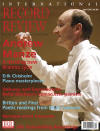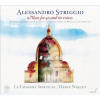Texte paru dans: / Appeared in:
*

International Record Review - (04/2012)
Pour
s'abonner / Subscription information
Glossa
GCDSA921623

8424562216235
Consultez toutes les évaluations recensées pour ce cd
~~~~ Reach all the evaluations located for this CD
It is less than a year since I reviewed the first recording of Alessandro Striggio’s great 40-part Mass which was resurrected by its discoverer Davitt Moroney at the Proms in London in July 2007 and then seized on by I Fagiolini and friends for one of the biggest Early Music get-togethers since Andrew Parrott recorded the sumptuous Florentine Intermedii of 1589 back in 1986 for EMI. Now the French have jumped on the bandwagon, though Hervé Niquet is at pains to point out that though the ‘official’ rediscovery and identification of the work is credited to Moroney, it was in fact a Frenchman, he says, who actually got there first: countertenor Dominique Visse transcribed Striggio’s Mass as long ago as 1978 and it’s his edition which is used as the basis for this new reading.
Striggio (c.1536-92), we may remember, worked for the great Renaissance patron of the arts Duke Cosimo I de’ Medici, whom he served in a dual role as both musician and diplomat. His 40-part motet Ecce beatam lucem was performed in Florence Cathedral in honour of two Papal envoys in 1561 and its success led ultimately to the composition of a 40-part Mass around 1566, based partly it seems on Striggio’s lost madrigal Ecco si beato giorno. Happy to blow his own trumpet as well as his master’s, Striggio took his prized Mass on tour to Brno, Munich and Paris where Charles IX and his mother Catherine de Médici were especially impressed.
To the casual ear Striggio’s harmonic writing sounds conservative and unadventurous; but we have to remember that these were the 1560s and Striggio was a pioneer. His use of real polychoral writing, in which each of the five eight-part choirs keeps its own independence, is virtually without precedent, and very different from Tallis’s approach in Spem in alium where all 40 voices are essentially equal. Once you acclimatize to Striggio’s scale, you begin to hear the expressive touches: the exciting banter between choirs, the sparing but telling use of the full ensemble and the sensuous polyphony at the opening of the ‘Sanctus’. The swelling of the 40 parts to an incredible 60 for the final ‘Agnus Dei’ requires a slowing down of the harmonic rhythm to accommodate the multitude, and the resulting sense of serene stasis offers a rapturous (if anachronistic) foretaste of twentieth-century minimalism.
The first major decision faced by a conductor is whether or not to opt for a purely vocal performance or mix in instruments as in early performances of Striggio’s 40-part motet Ecce beatam lucem. Like Hollingworth, Niquet also decides to include instruments, though they are only ever used to double the 40 vocal parts, whereas Hollingworth often uses his instruments in place of voices. So, not that they’re competing (or are they?), but Niquet wins by a whisker with 60 singers plus 18 instruments, while Hollingworth fields 42 singers and 33 instrumentalists.
With five eight-part choirs to play with, it makes perfect Renaissance sense to distinguish them by scoring. Niquet decides on two purely vocal choirs, two accompanied by keyboard instruments, and Choir III is reserved for special treatment: the top four singers are doubled by a quartet of high wind instruments and the bottom four voices by a cornett and three sackbuts. Overall, then, Niquet prefers the sound of predominantly vocal forces, with a little instrumental reinforcement. This is the major point of difference between the two recordings. Hollingworth is determined to make much more of the potential for contrast between the five choirs, and to this end gives each its own unique vocal and instrumental colour. He also colours and articulates the music on an almost phrase-by-phrase basis, leading to strikingly variegated textures and a madrigalian concern for text. Niquet, though, is altogether more long-breathed and sensuous, with more homogeneous textures which generate tremendous waves of sound and sweeping climaxes. It’s Niquet who really revels in the whole massive sonority of the music, delivering a 60-part final ‘Agnus Dei’ with much more slam than Hollingworth. The choral singing of Le Concert Spirituel is seductively sumptuous throughout, especially in the wonderfully spacious readings of the ‘Gloria’ and ‘Credo’.
In sum, the two approaches are both historically valid, musically convincing and atmospherically recorded (in the round). So, if you are thinking of adding a little Renaissance sumptuousness to your collection, your final decision might depend on the choice of accompanying pieces. Niquet sets his Mass in the context of a service for the feast day of St John in Florence Cathedral, with palette-cleansing liturgical interludes by the maestro di cappella during Striggio’s time, Francesco Corteccia (1502-71), and with some additional double-choir items by the later Italian polychoralist Orazio Benevoli (1605-72). Actually, Benevoli’s Magnificat, Laetatus sum and Miserere have no place in the celebration of a Mass, and there’s the suspicion that they just happened to be conveniently at hand: Niquet recorded them (less magnificently) for Naxos in 1995 (8.55 3636).
Splendid though Benevoli is, id much
rather have Tallis’s Spem in alium — the English response to
Striggio’s Ecce beatam lucem — in Hollingworth’s radically colourful
performance with instruments. He also offers us a glimpse of Striggio the
madrigalist plus a DVD with surround-sound versions of all the 40-part music
as well as a short behind-the-scenes documentary. So, on balance, though I
very much enjoy the sensuous sweep of Niquet’s approach, Hollingworth’s more
colourful Renaissance way and his more interesting and appropriate
accompanying items win me over – just.
Fermer la fenêtre/Close window
Cliquez l'un ou l'autre
bouton pour découvrir bien d'autres critiques de CD
Click either button for many other reviews


